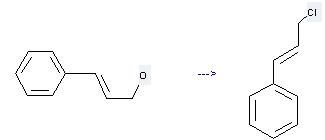-
Name
Cinnamyl chloride
- EINECS 220-246-4
- CAS No. 21087-29-6
- Article Data57
- CAS DataBase
- Density 1.076 g/cm3
- Solubility 200 mg/L (20 °C) in water
- Melting Point 7oC
- Formula C9H9Cl
- Boiling Point 239.6 °C at 760 mmHg
- Molecular Weight 152.623
- Flash Point 96.6 °C
- Transport Information UN 1760 8/PG 2
- Appearance Yellow - brown liquid.
- Safety 26-28-36/37/39-45-37/39
- Risk Codes 22-26-34-43-36/37/38
-
Molecular Structure
-
Hazard Symbols
 T+,
T+, Xn
Xn
- Synonyms Benzene,(3-chloro-1-propenyl)-, (E)-;Benzene, (3-chloropropenyl)-, (E)- (8CI);Benzene, [(1E)-3-chloro-1-propenyl]- (9CI);(E)-(3-chloro-1-propenyl)benzene;(E)-3-Chloro-1-phenyl-1-propene;(E)-3-Chloro-1-phenylpropene;(E)-3-Phenyl-2-propen-1-yl chloride;(E)-Cinnamyl chloride;(E)-Cinnamylchloride;[(1E)-3-Chloro-1-propenyl]benzene;trans-3-Chloro-1-phenylprop-1-ene;trans-3-Chloro-1-phenylpropene;trans-Cinnamyl chloride;
- PSA 0.00000
- LogP 2.93860
Cinnamyl chloride Specification
The Cinnamyl chloride, with the CAS registry number 21087-29-6, is also known as [(1E)-3-Chloroprop-1-en-1-yl]benzene. This chemical's molecular formula is C9H9Cl and molecular weight is 152.62. What's more, its IUPAC name is called [(E)-3-Chloroprop-1-enyl]benzene.
Physical properties about Cinnamyl chloride are: (1)ACD/LogP: 3.16; (2)# of Rule of 5 Violations: 0; (3)ACD/LogD (pH 5.5): 3.16; (4)ACD/LogD (pH 7.4): 3.16; (5)ACD/BCF (pH 5.5): 147.36; (6)ACD/BCF (pH 7.4): 147.36; (7)ACD/KOC (pH 5.5): 1240.87; (8)ACD/KOC (pH 7.4): 1240.87; (9)#H bond acceptors: 0; (10)#H bond donors: 0; (11)#Freely Rotating Bonds: 2; (12)Polar Surface Area: 0 Å2; (13)Index of Refraction: 1.577; (14)Molar Refractivity: 46.99 cm3; (15)Molar Volume: 141.7 cm3; (16)Surface Tension: 36.5 dyne/cm; (17)Density: 1.076 g/cm3; (18)Flash Point: 96.6 °C; (19)Enthalpy of Vaporization: 45.72 kJ/mol; (20)Boiling Point: 239.6 °C at 760 mmHg; (21)Vapour Pressure: 0.0614 mmHg at 25 °C.
Preparation of Cinnamyl chloride: this chemical can be prepared by 3t-Phenyl-prop-2-en-1-ol. This reaction needs reagents 2,4,6-trichloro[1,3,5]triazone, DMF and solvent CH2Cl2 at temperature of 25 °C. The reaction time is 15 min. The yield is 92 %.

Uses of Cinnamyl chloride: it is used to produce other chemicals. For example, it can react with Acetoacetic acid ethyl ester to get 2-trans-Cinnamyl-acetoacetic acid ethyl ester. The reaction occurs with reagents potassium carbonate, acetone.

When you are dealing with this chemical, you should be very careful. This chemical is inflammation to the skin, eyes and respiratory system or other mucous membranes. It at very low levels cause damage to health and it is very toxic by inhalation. If swallowed, it's harmful to health. Therefore, you should wear suitable protective clothing, gloves and eye/face protection. In case of contacting with eyes, you should rinse immediately with plenty of water and seek medical advice. And in case of accident or if you feel unwell seek medical advice immediately.
You can still convert the following datas into molecular structure:
(1) SMILES: ClC/C=C/c1ccccc1
(2) InChI: InChI=1S/C9H9Cl/c10-8-4-7-9-5-2-1-3-6-9/h1-7H,8H2/b7-4+
(3) InChIKey: IWTYTFSSTWXZFU-QPJJXVBHSA-N
Related Products
- Cinnamyl 3,4-dihydroxy-alpha-cyanocinnamate
- Cinnamyl acetate
- Cinnamyl alcohol
- Cinnamyl benzoate
- Cinnamyl bromide
- Cinnamyl Butyrate
- Cinnamyl chloride
- Cinnamyl chloride
- Cinnamyl cinnamate
- Cinnamyl formate
- 21087-64-9
- 210880-92-5
- 210884-99-4
- 210885-00-0
- 21089-13-4
- 21089-18-9
- 210907-84-9
- 210963-78-3
- 210963-93-2
Hot Products
About|Contact|Cas|Product Name|Molecular|Country|Encyclopedia
Message|New Cas|MSDS|Service|Advertisement|CAS DataBase|Article Data|Manufacturers | Chemical Catalog
©2008 LookChem.com,License: ICP
NO.:Zhejiang16009103
complaints:service@lookchem.com Desktop View